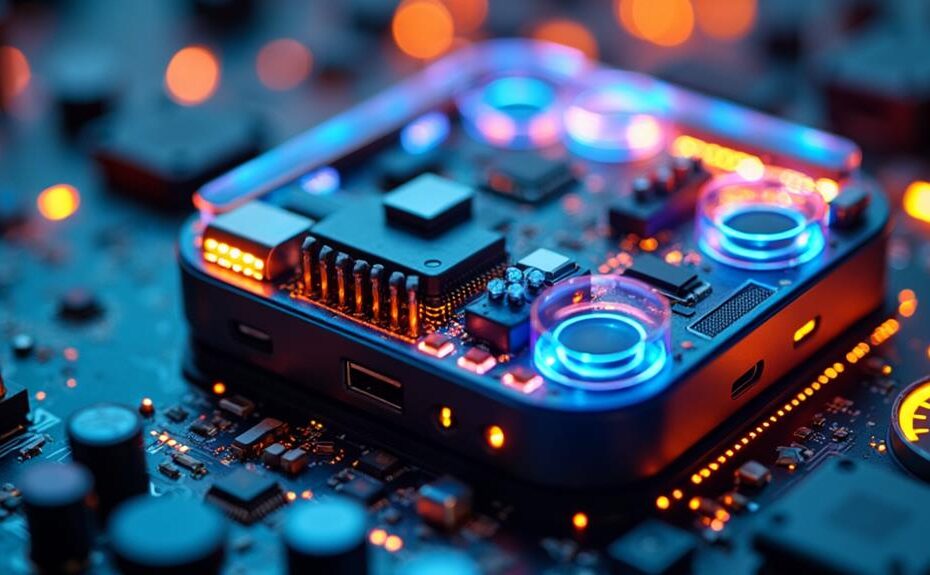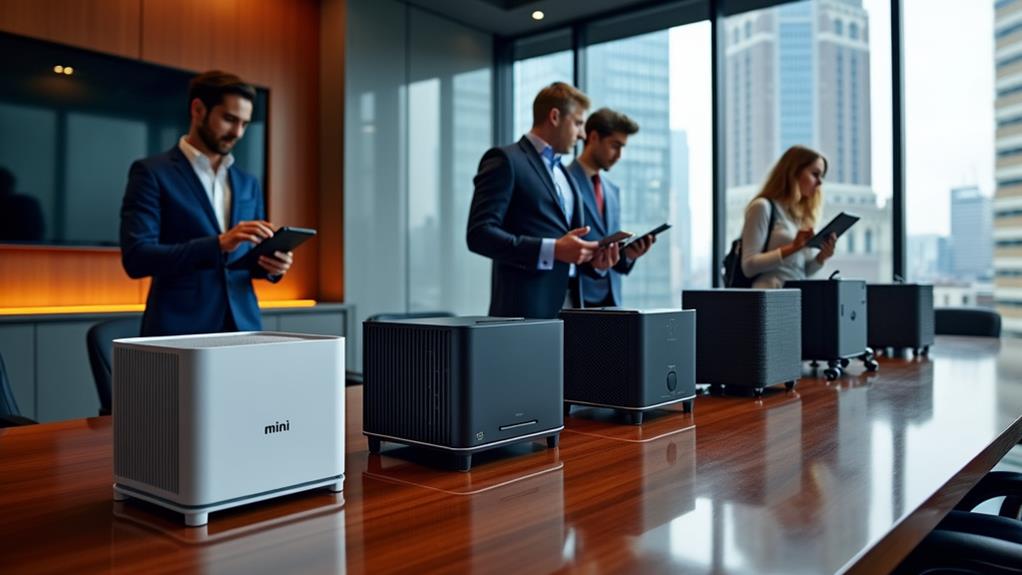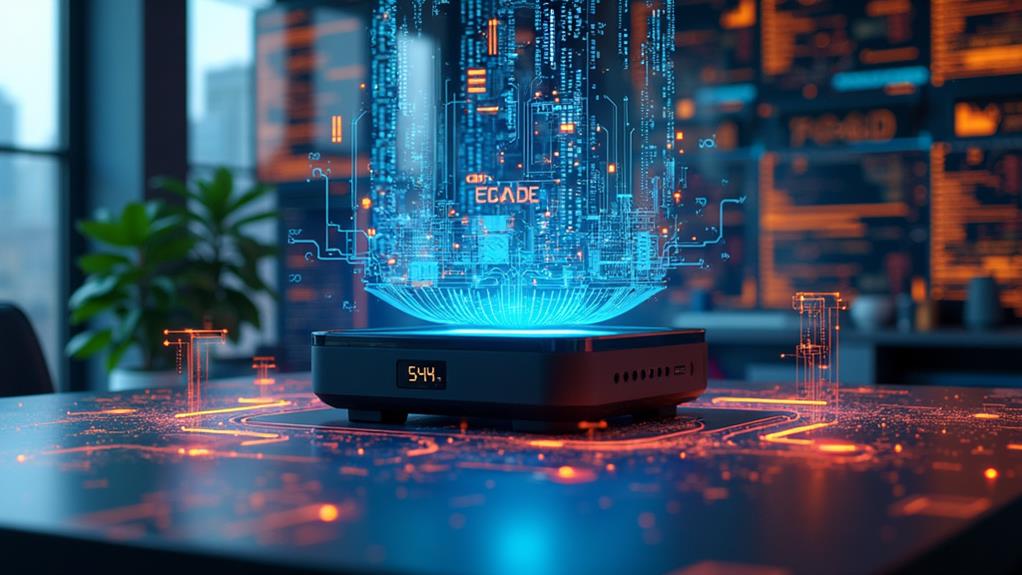



To improve your Mini PC's boot time, start by upgrading from an HDD to an SSD, which can speed things up by up to 70%. Next, minimize startup programs using Task Manager; disable any unnecessary applications that load at startup. Regularly perform system maintenance, such as disk cleanups and malware scans, to keep your system running smoothly. Additionally, check your BIOS settings; enable Quick Boot and set your primary boot drive as the first option. These steps will greatly enhance performance, and as you explore further, you'll discover even more ways to optimize your Mini PC.
Key Takeaways
- Upgrade from an HDD to an SSD to significantly reduce boot times by up to 70%.
- Disable unnecessary startup programs using Task Manager or System Configuration for a faster boot process.
- Increase RAM capacity from 4GB to 8GB or more to improve multitasking and boot performance.
- Regularly update the BIOS and ensure the primary boot drive is set as the First Boot Device for optimized boot speed.
- Perform routine malware scans and system maintenance to keep your Mini PC running efficiently and reduce boot delays.
Understanding Boot Time Issues
Boot time is a critical performance metric for Mini PCs, and understanding its underlying issues can help you optimize your system. Slow boot times often stem from a combination of outdated hardware, excessive startup programs, and malware infections, all of which can hinder your Mini PC's performance. Each new version of Windows comes with increased demands on storage and memory, which can negatively impact boot performance, especially in systems with limited resources. Additionally, the compact and energy-efficient nature of Mini PCs can lead to hardware constraints that affect boot times, making it essential to evaluate the advantages of Mini PCs in industrial applications when assessing performance. The Power-on Self-Test (POST) process also plays a considerable role in boot time. It checks all hardware components during startup, leading to longer boot times as you add more peripherals that require additional drivers. One effective way to enhance boot time is to upgrade from a traditional HDD to an SSD. SSDs are known to provide notably faster boot times, with many users experiencing reductions of 40% or more after the upgrade.
Optimizing Startup Programs
To enhance boot speed further, optimizing startup programs is key. When you press the power button, the operating system loads various applications that can greatly affect your boot time. By using Task Manager or System Configuration (msconfig), you can disable unnecessary startup programs, preventing non-essential applications from loading at startup. This is particularly important in corporate environments where performance bottlenecks can hinder productivity. Start by identifying and prioritizing these programs based on their impact on boot performance. Focus on disabling those that slow the process the most. Regularly review your installed applications to catch any bloatware that may be set to run at startup, freeing up valuable system resources for crucial tasks.
Additionally, consider setting essential programs to manual startup rather than automatic. This approach allows your system to boot faster by loading only critical applications initially. If you prefer a streamlined experience, third-party software tools can help you manage and optimize startup applications effectively.
Hardware Upgrades for Speed
Upgrading hardware components is one of the most effective ways to greatly enhance your mini PC's boot speed. For instance, switching from a traditional HDD to an SSD, like the 500GB NVMe SSD found in the Beelink Mini PC, can reduce boot times by up to 70%, considerably improving system responsiveness. If you're currently using 4GB of RAM, consider upgrading to 8GB or more. This not only aids multitasking but can also decrease boot times, especially on resource-intensive operating systems like Windows 10.
Guarantee your data cables are high-speed and compatible with your motherboard. This optimization can enhance data transfer rates during the boot process. Additionally, regularly replacing aging power supplies is essential. An unstable power supply can slow down boot performance, so guarantee reliable power delivery to your components.
Lastly, don't overlook the importance of BIOS updates. Keeping your firmware current can provide optimizations that enhance boot efficiency, making it a critical step in your hardware upgrade plan. By focusing on these upgrades—SSD, RAM, power supply, and BIOS updates—you'll create a faster, more efficient boot experience for your mini PC.
System Maintenance Practices
Your mini PC's performance hinges not just on hardware but also on effective system maintenance practices. To boost boot performance, regularly run disk cleanup utilities to eliminate unnecessary files cluttering your storage. This simple step can greatly enhance your system's efficiency. If you're using a traditional HDD, utilize defragmentation tools to optimize read/write speeds. Remember, though, this isn't applicable for SSDs.
Schedule periodic checks for corrupted system files using the Windows built-in System File Checker (SFC). This helps maintain system integrity and guarantees your boot process remains efficient. Keeping your operating system and drivers updated is essential as well; updates often address bugs that could slow your boot times.
Additionally, perform routine malware scans to detect and eliminate potential threats that might degrade your boot performance. Malware can greatly impact startup processes, so staying proactive is key. By implementing these system maintenance practices, you'll not only improve boot times but also enhance overall performance, guaranteeing your mini PC runs smoothly and efficiently.
Advanced BIOS Configuration
In today's fast-paced computing environment, optimizing boot times through advanced BIOS configuration can make a significant difference. Start by setting your primary boot drive as the First Boot Device. This guarantees your system boots from the fastest option available, typically an SSD, enhancing overall power and efficiency.
Next, enable the Quick Boot option in BIOS. This feature skips certain hardware checks during startup, allowing Windows to load faster. Additionally, disable unnecessary boot devices, such as USB ports or optical drives, to minimize hardware checks, which can further streamline the boot process.
Regularly updating your BIOS is essential. The latest versions often include performance enhancements and faster boot configurations, so don't overlook this step. You can also configure BIOS settings to disable hardware components that aren't needed during boot. This helps to reduce load times and creates a more efficient startup environment.
Disclosure: As an Amazon Associate, I earn from qualifying purchases.



